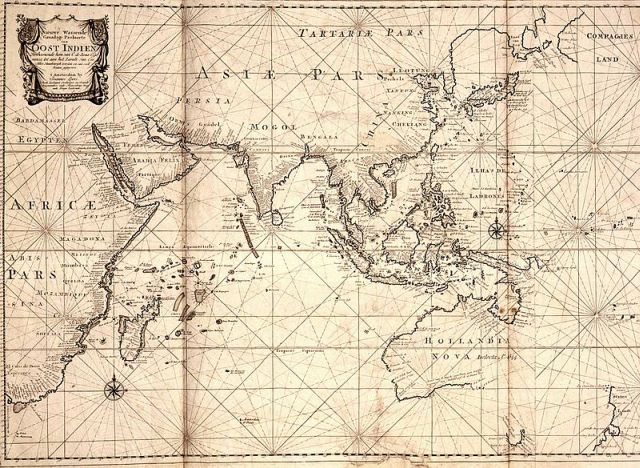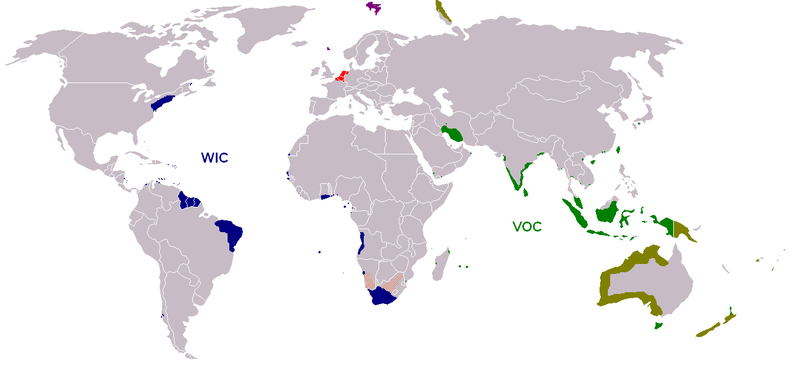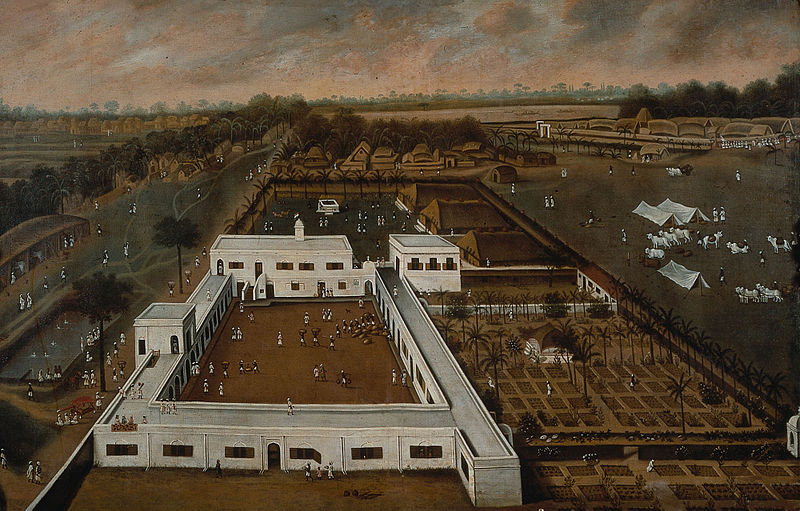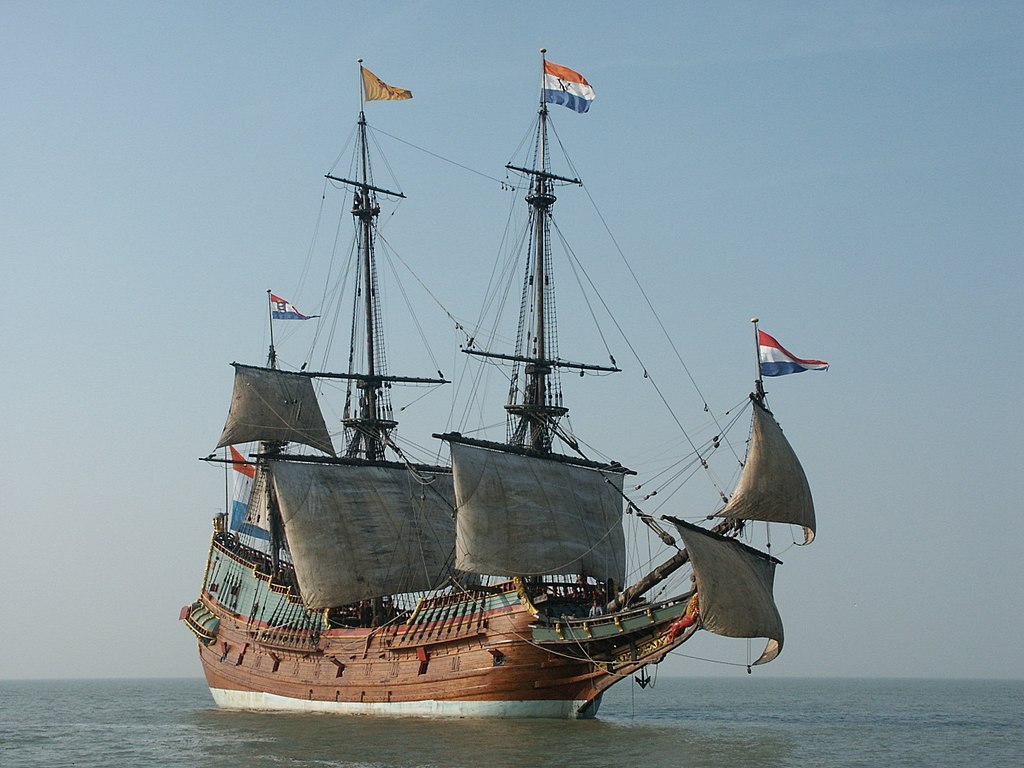There is no story of the Netherlands compete without the country’s colonial past. As a significant colonial empire, the Northern Netherlands had a great impact on the history of the world and several countries, where traces of the Dutch influences are still more or less visible.
This influence was, of course, mutual (more on this in Colonial heritage). As a great colonial player, Republic of the United Provinces (Northern Netherlands) occurred only in the 17th century. Up to this time the only significant colonial powers were Spain and Portugal, which shared control over the so called New World, according to the bull of Pope Alexander VI from 1494. One of the major areas of the rivalry between them was Far East, so called Eastern Indi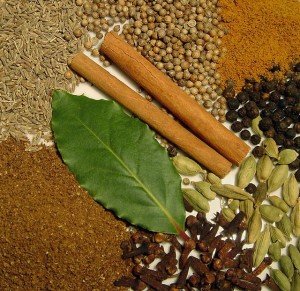 a (formally assigned to Portugal), a main supplier of highly desirable (and very expensive in Europe!) spices, such as pepper, cinnamon, cloves, nutmeg, cardamom and vanilla. By the end of the 16th century Dutch traders were only intermediaries in the spice trade, buying them from the Portuguese. The situation had changed after conquering Portugal by Spain (1580) and the outbreak of the Eighty Years War (1568-1648), which resulted in difficulties with the trade for Dutch merchants as Spain used to stop them. Not without significance was the rise of the power of the Dutch merchants who decided to obtain colonial goods on their own. First expeditions, financed mainly by Amsterdam merchants, set off in the years 1582, 1598 and 1595 to the Far East, reaching Java, which later became one of the most important trade centers of the colonial Netherlands.
a (formally assigned to Portugal), a main supplier of highly desirable (and very expensive in Europe!) spices, such as pepper, cinnamon, cloves, nutmeg, cardamom and vanilla. By the end of the 16th century Dutch traders were only intermediaries in the spice trade, buying them from the Portuguese. The situation had changed after conquering Portugal by Spain (1580) and the outbreak of the Eighty Years War (1568-1648), which resulted in difficulties with the trade for Dutch merchants as Spain used to stop them. Not without significance was the rise of the power of the Dutch merchants who decided to obtain colonial goods on their own. First expeditions, financed mainly by Amsterdam merchants, set off in the years 1582, 1598 and 1595 to the Far East, reaching Java, which later became one of the most important trade centers of the colonial Netherlands.
East Indie, map of VOC, 1700
The essence of Dutch colonialism was that it was not been created by the state, but by merchant companies, which got from the United Provinces a monopoly on trade and the extensive powers. This way the authorities of the United Provinces deprived themselves of effective control over the future colonies. These companies were united in two structures (company from compagny means comradeship):
– The Dutch East India Company (Verenigde Oost-Indische Compagnie – VOC), existing in the years 1602 – 1798
– Dutch West India Company (West-Indische Compagnie – WIC), existing in the years 1621 – 1674 / 1675 –1792
VOC and WIC colonies
Dutch colonial system was very different from the systems set up by the Spanish, the Portuguese and the British. It was based on the cooperation and loyalty of the local rulers, and not on the authority of viceroys delegated by the metropolis, or on direct subordination to the king. Besides the Dutch colonization was characterized by religious tolerance – Christianity was almost never introduced by power (so results were also not very impressive). Another distinguishing feature was the international aspect of the Dutch colonialism. Due to the insufficient number of Dutch people willing to go to the colonies both companies had to use of volunteers of other nationalities, including Germans, French, Scandinavians, Swiss, Jews and Poles. Among the latter the most famous person is Krzysztof Arciszewski, who was even temporarily the Lieutenant Governor and commander in chief of the Dutch troops in New Holland (Brazil).
Dutch factory in Bengal, Hendrik van Schuylenburg 1665
Colonization can be divided into two phases:
- merchant (VOC and WIC) – 17-18th centuries
- state – 19-20th centuries
The reason of the infamous end of the first stage was a deep degeneration of the colonial system due to the smuggling, corruption of the poorly paid officials, illicit trade outside of the company, increasing costs of the colonial administration, insufficient spending on defense, a lack of qualified staff. All those weaknesses ultimately led to the bankruptcy of the company. The end of the second phase was due to liberation movements after World War II. And don’t forget of the colonial rivalry with Great Britain, which seized big part of the overseas possessions of the Netherlands.
Replica of the colonial ship “Batavia”
Some of those colonies were kept by the Northern Netherlands for a short time only. The longest lasting possession was the area nowadays covered by Indonesia, the country founded on the ruins of the Dutch India. The legacy that the Dutch left behind is also different here and there. But for the Northern Netherlands its colonial period proved to be invaluable. Thanks to profits from Eastern India a small Republic of the United Provinces built in 17th century its economic power, what happened again in the 19th century, at the time of the Kingdom of the Netherlands. 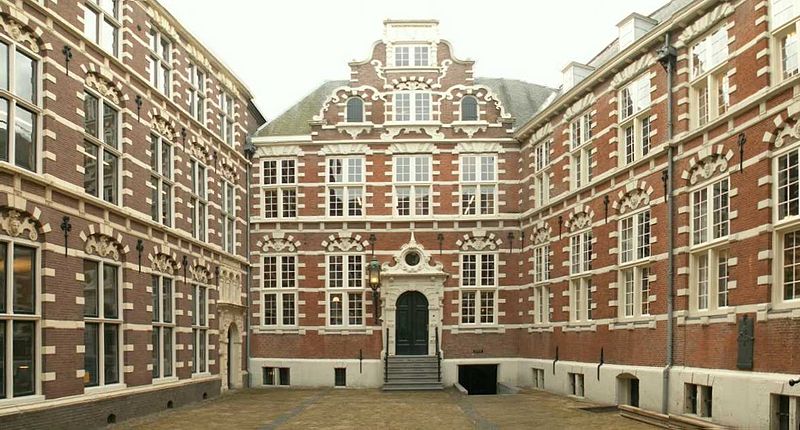
VOC huis in Amsterdam
At present, the overseas territories of the Netherlands consist of only three islands of the Lesser Antilles: Bonaire, Saba and Sint Eustatius, which have the status of special municipalities. This is what remains of the once great colonial empire of the Northern Netherlands.
By the way… important notes
The Republic of the Seven United Provinces was never as a state involved in colonies! Until the Batavian Republic they were just commercial properties of commercial companies, outside the Netherlands. When these went bankrupt, the Batavian Republic took these lands over as colonies. That republic had no other option. The Batavian Republic was not given the time to organize things properly because French invaded the republic and forbid Dutch fleet to sail, so the English took almost all of these areas. After that time, when the French left the Netherlands, it was as an extremely poor country. So the Netherlands had to be rebuilt. The poorest part of the young Kingdom – United Kingdom of the Netherlands (1815 – 1830) – were the southern provinces (present Belgium), so almost every penny the northern provinces could spend was invested there on roads, channels, housing, etc. The southern provinces had a higher population, no polders and dikes to maintain and a very short robust coastline, so they could spend almost every guilder they earned for food, etc. The northern provinces had to think twice before they spend that first guilder. When the economical situation improved (so profits came) these provinces broke away from the kingdom. So the kingdom became, as a nation, poor again. So reorganisation of the colonies took too much time.
What concern politics – the Dutch often used to buy their colonies from the locals, what was more expensive than just capturing it. Most time, having a practical relation with the former owners, it ment less costs for the defence. Doing both was economicaly not really possible because of the competition with other countries.
Beside of Manhattan, also Conijnen-eiland (Island of the rabbits), now Coney Island, was bought. These islands were paid for in goods like hunting rifles, blankets, etc., so not for the old golden guilders. To compare them with modern values is rather tricky!
In the following chapters, the Dutch colonial activity has been discussed with the division on the continent.
Renata Głuszek and Han Tiggelaar
Photo: Wikimedia Commons

